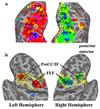Topographic maps in human frontal and parietal cortex
- PMID: 19758835
- PMCID: PMC2767426
- DOI: 10.1016/j.tics.2009.08.005
Topographic maps in human frontal and parietal cortex
Abstract
Retinotopic mapping of functional magnetic resonance (fMRI) responses evoked by visual stimuli has resulted in the identification of many areas in human visual cortex and a description of the organization of the visual field representation in each of these areas. These methods have recently been employed in conjunction with tasks that involve higher-order cognitive processes such as spatial attention, working memory, and planning and execution of saccadic eye movements. This approach has led to the discovery of multiple areas in human parietal and frontal areas, each containing a topographic map of visual space. In this review, we summarize the anatomical locations, visual field organization, and functional specialization of these new parietal and frontal topographic cortical areas. The study of higher-order topographic cortex promises to yield unprecedented insights into the neural mechanisms of cognitive processes and, in conjunction with parallel studies in non-human primates, into the evolution of cognition.
Figures


References
-
- Kaas JH. Topographic maps are fundamental to sensory processing. Brain Res. Bull. 1997;44:107–112. - PubMed
-
- Inouye T. Die Sehstörungen bei Schussverletzungen der kortikalen Sehsphäre nach Beobachtungen an Versundeten der letzten Japanische Kriege. Wilhelm Engelmann; 1909.
-
- Glickstein M, Fahle M. Visual Disturbances Following Gunshot Wounds of the Cortical Visual Area. Oxford University Press; 2000.
-
- Engel SA, et al. fMRI of human visual cortex. Nature. 1994;369:525. - PubMed
-
- Wandell BA, et al. Visual field maps in human cortex. Neuron. 2007;56:366–383. - PubMed
Publication types
MeSH terms
Grants and funding
LinkOut - more resources
Full Text Sources

